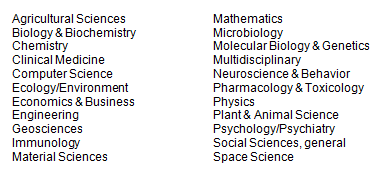Overview
Essential Science Indicators is sourced from the Science Citation Index-Expanded (SCIE) and the Social Sciences Citation Index (SSCI) in Web of Science Core Collection.
Document Types
ESI analyzes articles and reviews from SCIE and SSCI journals to determine how well a paper, organization, etc. is performing. Letters, editorial materials, corrections, etc. aren’t regularly cited and, therefore, aren’t included in ESI calculations.
Depth of Data
ESI data consists of a 10-year rolling file, which increases with each bimonthly update, accumulating up to 11 years. After 11 full years of data are added, the first year is then dropped, setting the file back to a 10-year period.
Fields
ESI uses 22 broad disciplines to rank entities and identify top-performing papers. Each journal is assigned to only one field, and the research published in that journal will take on that field assignment.
In the case of Multidisciplinary journals, reclassification is done at the paper level, based on an analysis of the cited references. This means that papers published in journals like Science and Nature could belong to fields that are more specific than Multidisciplinary.

Citation Counts
Only citations from indexed journals in the Science Citation Index Expanded, Social Science Citation Index and Arts & Humanities Citation Index, are taken into account for ESI purposes. Citations coming from books, conference proceedings, or journals indexed in the Emerging Sources Citation Index will not be included in the citation counts for papers or groups of papers.
ESI Citation Thresholds
Inclusion in ESI is dependent upon meeting certain citation thresholds. Only the most highly cited individuals, institutions, journals, countries and papers are included in ESI. This chart shows the citation thresholds that must be met in order to appear in ESI.
| Entity | Percentile | Data Years |
|---|---|---|
| Researchers | 1% | 10 |
| Institutions | 1% | 10 |
| Countries | 50% | 10 |
| Journals | 50% | 10 |
| Highly Cited Papers | 1% | 10 |
| Hot Papers | 0.1% | 2 |
How to Read This Table: This table shows you the citation performance threshold that an entity's research needs to meet in order for it to qualify as Highly Cited in a field. Data Years refers to the years examined - 10 means that the full ESI data file is considered. Percentiles![]() The term ”percentile” designates a citation threshold at or above that at which a fixed fraction of the papers fall. This term is used to denote any fixed fraction of top papers ordered by citation count. The levels we have selected for listing by field and year are 0.01%, 0.1%, 1.0%, 10%, 20%, and 50%. are inverted, so 1% means that an entity is performing in the top 1% when compared to peers.
The term ”percentile” designates a citation threshold at or above that at which a fixed fraction of the papers fall. This term is used to denote any fixed fraction of top papers ordered by citation count. The levels we have selected for listing by field and year are 0.01%, 0.1%, 1.0%, 10%, 20%, and 50%. are inverted, so 1% means that an entity is performing in the top 1% when compared to peers.
Examples
To be included as a Highly Cited Researcher in Chemistry, the total number of citations to a person’s Chemistry output must be in the top 1% when compared to all other researchers, who have published Chemistry papers in the last 10 years. Each author listed on a paper is counted equally.
Highly Cited Papers are papers that have received enough citations to place them in the top 1% when compared to all other papers published in the same year in the same field, i.e. 2008 Physics papers are only compared to other 2008 Physics papers to determine whether they have been cited enough to rank in the top 1%.
For Hot Papers, only papers published in the last 2 years are considered. Hot Papers are receiving citations quickly after publication. These papers have been cited enough times in the most recent bimonthly period to place them in the top 0.1% when compared to peer papers. Peer papers are papers that were added to WoS Core Collection during the same bimonthly update and belong to the same field.
